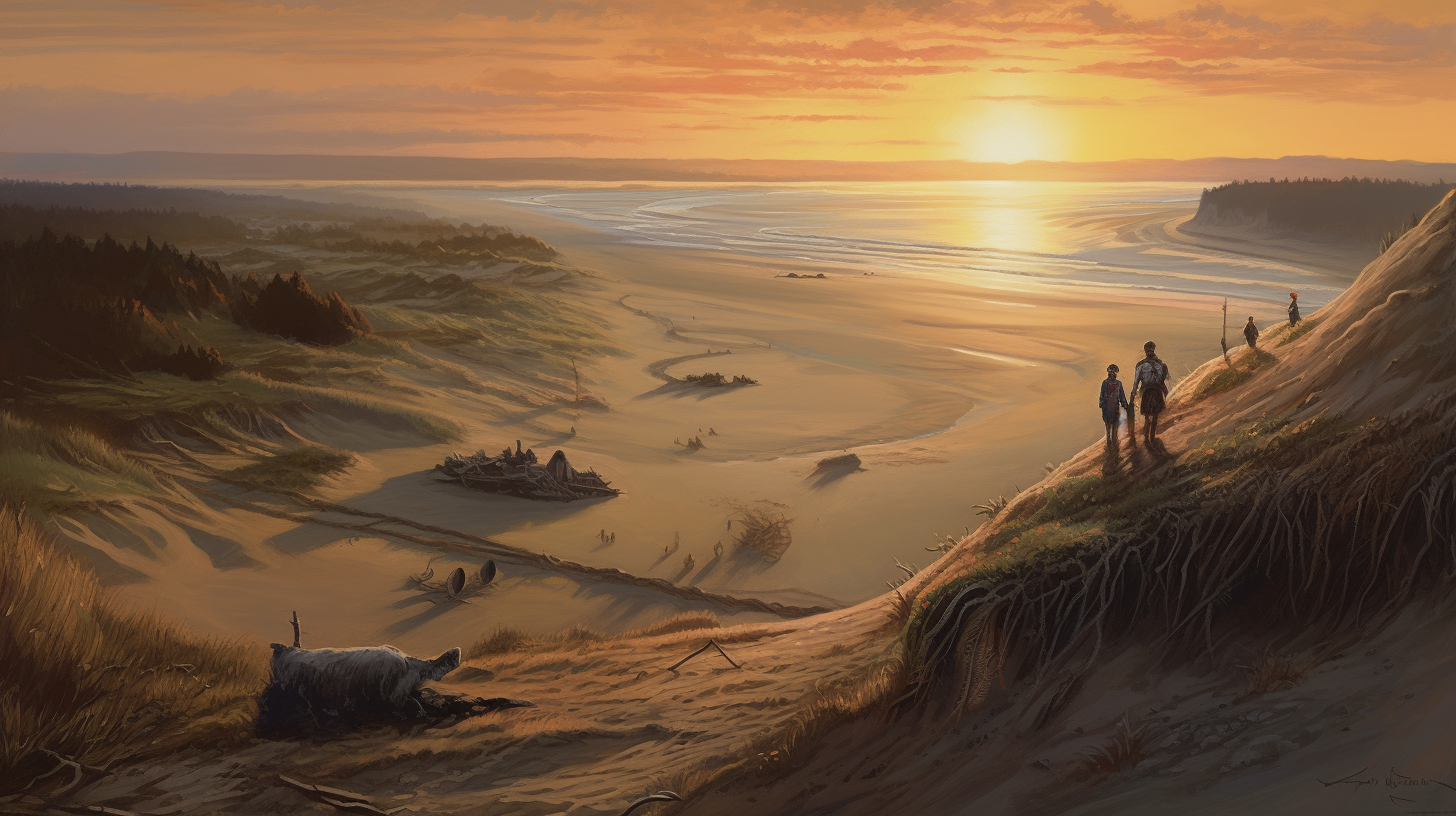
Unearthing the Secrets of Oregon’s Coast: The Tahkenitch Landing Site and its 8,000-Year-Old History
In the serene surroundings of the Oregon coast, archaeologists have uncovered the ancient secrets of a unique site that has provided valuable insights into the lives of the region’s early inhabitants. Located seven miles north of Reedsport on the Siuslaw National Forest, the Tahkenitch Landing site has produced archaeological finds dating back as far as 8,000 years ago, offering a rare glimpse into the relationship between the coast’s inhabitants and their ever-changing environment.
Molly Kirkpatrick, an archaeologist with the Siuslaw National Forest, provided an overview in January 2022 of previous archaeological research and the results of recent geoarchaeological investigations at the Tahkenitch Landing Site in a presentation titled “Early Period of Occupation at the Tahkenitch Landing Site & Surrounding Area” (https://www.youtube.com/watch?v=RFToLvecIEQ). The presentation included a general overview of landscape evolution along the Central Oregon Coast since the last ice age and its influence on the preservation and distribution of archaeological sites along the coastal front.
Originally a fishing resort in the 1930s, the Tahkenitch Landing site was acquired by the Forest Service in the 1970s. Archaeological excavations began in the early 1980s and revealed evidence of occupation dating back around 8,000 years, with the most intense period of occupation occurring between 5,200 and 3,000 years ago. The site was classified as a shell-midden village site, characterized by high concentrations of shellfish remains, marine mammal bones, and various types of stone tools and bone and antler artifacts.
The significance of the Tahkenitch Landing site lies in the evidence it provides for early occupation by Native Americans in the area, highlighting the importance of conservation and further study to understand the history and cultural significance of such sites. The subsistence strategies at this site shifted from marine resources to estuarine resources and then to freshwater resources, reflecting the changing environment due to the migration of dunes and the formation of the freshwater lake.
The research conducted at the site contributes to the understanding of early coastal occupation and the potential coastal migration route into the Americas. However, finding archaeological sites along the coast is challenging due to sea level fluctuations, coastal erosion, and the use of perishable materials by early inhabitants. Additionally, the preservation of archaeological sites in the landscape is influenced by factors such as geography, climate, soils, and human choices.
The central Oregon coast lacks an abundance of raw lithic materials, leading to the heavy use of perishable materials such as wood, fiber, antler, bone, and shell. These materials do not preserve well in acidic soils, but the shell midden at Tahkenitch alters the soil alkalinity, favoring preservation. Most shell-midden sites along the coast are younger, typically not older than 4,000 years.



The research at the Tahkenitch Landing site is part of a larger effort to uncover the ancient history of the Pacific Northwest Native Americans living on the Oregon Coast. Other local shell middens include Devil’s Kitchen, Black Lock Point, Indian Sands, Yachats, and Neptune State Park. These sites, along with the Tahkenitch Landing site, contribute to the growing body of knowledge on late Pleistocene and early Holocene deposits, which can help researchers develop meaningful models to determine site expectations and better understand the early occupation of the Oregon coast.
The findings from the Tahkenitch Landing site not only provide valuable information about the early inhabitants of the region but also have implications for the management of cultural resources in the area. As researchers continue to explore and uncover more about the history of Oregon’s coast, they hope to gain a deeper understanding of the people who once called this beautiful landscape their home.
As fascinating as the discoveries at the Tahkenitch Landing site and other similar archaeological sites along the Oregon coast are, they also present an intriguing idea. It is possible that the Pacific coast has been inhabited for a period longer than the existence of the pyramids. However, due to the numerous sites that are now underwater or have deteriorated over time because of inorganic materials, we may never truly know how advanced the first people in our area became.
The Native Americans who inhabited the Oregon coast exhibited remarkable adaptability and resourcefulness, living off the seasonal land without relying heavily on consistent farming practices. Instead, they developed a deep understanding of their environment and utilized the abundant natural resources available to them, such as marine life, estuarine resources, and freshwater resources, as evidenced by the Tahkenitch Landing site findings.
Their ability to sustain themselves by living off the land demonstrates a level of sophistication and knowledge that may have been more advanced than what we currently understand. Unfortunately, much of the evidence that could shed light on the true extent of their advancements has been lost due to factors such as sea level fluctuations, coastal erosion, acidic soil conditions, and the use of perishable materials in their daily lives.
Despite these challenges, the research conducted at the Tahkenitch Landing site and other similar archaeological sites along the Oregon coast continues to provide valuable insights into the lives of the region’s early inhabitants. By studying these sites and preserving the cultural resources that remain researchers and archaeologists, hope to piece together a more complete picture of the ancient history of the Pacific Northwest Native Americans living on the Oregon Coast.
As we continue to uncover the secrets of Oregon’s coast and its ancient history, we may eventually gain a deeper understanding of the first people who called this beautiful landscape their home. These findings serve as a reminder of the rich cultural heritage that lies beneath the surface, waiting to be discovered and appreciated by future generations.
